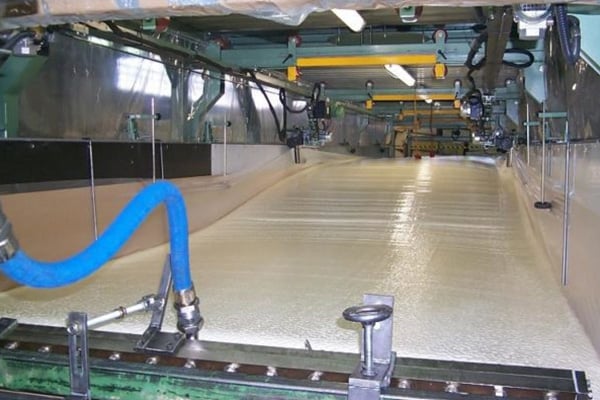DOD Technologies specializes in the low-level detection of toxic, corrosive, and flammable gases. We offer a broad range of detectors that utilize various detection principles. Each principle provides unique benefits and advantages. These technologies allows us to offer the most comprehensive portfolio of low-level gas detection systems available.
Below are a few primary spaces where products from DOD Technologies are commonly found. For more information, contact us today!
Semiconductor
Semiconductor manufacturing involves the use of toxic and flammable gas. Phosphine (PH3), Arsine (AsH3), Boron Trichloride (BCl3) and Gallium are commonly used as doping agents. Hydrogen (H2) is used both as a reactant and a reducing atmosphere carrier gas. Etching and cleaning gases include Ammonia and other perfluoro compounds.
Gas detection best practices protect both the life safety of workers as well as the valuable assets in the fab. Common locations for gas detection include – (1) ambient air, (2) gas cabinets, (3) valve manifold boxes, (4) gas storage. Alternate locations include tool-specific valve boxes, hydrogen distribution boxes, vacuum pump enclosures, and abatement systems.
Toxic gases typically found in the semiconductor industry include hydrides, mineral acids, oxidizers (such as chlorine & fluorine), and ammonia. Our signature line of ChemLogic® fixed gas detectors provides the fastest-responding, most reliable form of detection for these highly-toxic gases.
Combustible gases found in a fab provide a different detection challenge than the toxics. The New Cosmos single-point detector (PS-7) provides quick and repeatable readings of combustibles at both %LEL or ppm levels.
Spot-checking devices have become increasingly important with the ever-demanding schedules of semiconductor. The portable ChemLogic® (CLPX) and handheld electrochemical detector (XPS-7) provide users with lightweight and ready-to-go equipment needed for unforeseen events.
To browse a range of products intended for the Semiconductor industry, please click here.
Foam Manufacturing

Foam produced from polyurethane is used in so many facets of today’s everyday life we tend to take it for granted. From mattresses to adhesives to packaging to children’s toys, foam is all around us. The manufacture of polyurethane foam requires toxic gases, most commonly in the form of the diisocyanate family of gases.
Toluene diisocyanate (TDI) and Methylene diphenyl diisocyanate (MDI) have exposure limits set by the Occupational Safety and Health Administration (OSHA) to ensure employee protection in polyurethane facilities. The standard in some setting are as low as the parts per billion (ppb) levels.
It is recommended that several samples are taken at key locations along the production line to truly evaluate the risk of exposure. This approach will require a combination of Personal Badges, Portable ChemLogic® Detectors (CLPX) and Fixed ChemLogic® Monitors (CL1).
All of these forms of detection will provide reliable and repeatable results at the lowest levels of diisocyanate detection. The portable and fixed system will detect MDI and TDI down to 1 ppb.
To browse a range of products intended for the Foam Manufacturing industry, please click here.
Specialty Chemical

Chemical plants manufacture myriad of products and feedstocks. The nature and diversity of chemicals used and produced on site provide considerable danger to assets and personnel. These plants often use a wide range of both flammable and toxic gases in their manufacturing processes. The most common byproducts include Acetylene (C2H2), Ammonia (NH3), Helium (He), Hydrogen (H2), Hydrogen Fluoride (HF), Methanol (CH3OH), Nitric Acid (HNO3), and Volatile Organic Compounds (VOCs).
The transferring of gas into other containers or to other parts of the plant is the most common release of gases into the air. Portable and fixed gas detectors working together in a system provides the most comprehensive and effective gas detection plan at a facility with so many potential dangers.
Low-level handheld gas detectors provide effective and flexible gas detection at chemical plants. The Gascheck Helium Detector (G3) can detect helium at the lowest detectable levels, while our combustible handheld detectors monitor ppm levels of multiple gases. These monitors can spot-check bottles right off the truck, or respond to an unforeseen gas leak.
Novel development of new gas & chemical mixes have no detection precedent. An FTIR Detector can detect and specify virtually any gas, chemical, or odor in an industrial process. It accomplishes this through analyzation of the gas’s infrared spectra. The spectra provides a fingerprint of the air samples, which can identify virtually any combination of chemicals.
To browse a range of products intended for the Specialty Chemical industry, please click here.
Emergency Response
Emergency response to gas leaks can be hesitant and not as responsive as required without the correct gas detection. Hazmat and Emergency Response Teams identify the presence of toxic chemicals and combustible materials before entering a potential dangerous area.

First responders cannot tell in advance what specific chemical hazards to expect. This requires the need for broadband meters like the Tiger Handheld VOC Detector (TIGER), which incorporates a photoionization detection (PID) sensor with over 700 response factors for Volatile Organic Compounds (VOCs).

A personal detector such as the Blackline Connected Worker Device (G7C) simultaneously detects four gases. This cutting-edge monitor provides monitoring for Carbon Monoxide (CO), Hydrogen Sulfide (H2S), combustible gases (H2, CH4), and Oxygen (O2) depletion. It also offers lone worker capabilities, which gives site leads real-time monitoring over an entire fleet of workers at one time, in one place.

For more specific gas and low-level gas detection, such as emergency response at a semiconductor fab. The Portable ChemLogic® Detector (CLPX) detects dopant gases down to their lowest levels. The Portable Electrochemical Detector (XPS-7) also provides ppm level detection for many toxic found in the high tech industry.
To browse a range of products intended for Emergency Response, please click here.
Wastewater Treatment

Water purification and wastewater treatment processes produce a wide variety of toxic and combustible gas hazards that must be monitored on a continuous basis. Toxic gases also can build up in confined spaces, depleting oxygen and making those locations highly dangerous for plant personnel.
Fixed gas detection monitors placed correctly along the process in the plant can warn against dangerous gas situation. The most common gas hazards include combustible gases, specifically Methane (CH4), and toxic Hydrogen Sulfide (H2S). Other wastewater byproducts include Ammonia (NH3), Carbon Monoxide (CO), Chlorine (Cl2), Nitrous Oxide (N2O), Ozone (O3), Volatile Organic Compounds (VOCs), and Oxygen (O2) deficiency.
Intrinsically-safe detectors provide the most realiable form of detection im wastewater treatment facilities. The Class I Division 1 Toxic Gas Detector (GTD-2000TX) provides sensors for a wide range of hazardous gases, while its Combustible Detector (GTD-2000EX) counterpart detects all flammable gases.
Both of these detectors easily configure into existing installs with other manufacturers’ detectors. They both come equipped with analog and digital protocols. These flexible units can also be integrated with an independent Controller for both small (PS-7016) or large (PS-7064) installations.
To browse a range of products intended for the Wastewater treatment industry, please click here.
Oil & Petrochemical

The oil drilling and production industry covers a significant number of upstream activities, from offshore exploration to oil and gasoline production to end user markets. Gases such as Hydrogen Sulfide (H2S) and Sulfur Dioxide (SO2) are commonly found in the exploration drilling process. While, Oxygen (O2) depletion and other hydrocarbon gases pose larger risks downstream.
As refineries convert crude oil into different chemical blends, the byproducts pose a risk to workers and processes. The petrochemical industry produces several toxic gases including Benzene (C6H6), Ethylene (C2H4), Propylene (C3H6), Toulene (C7H8), Volatile Organic Compounds (VOCs), and combustible gas mixtures.
Exploration drilling rigs and production platforms require portable gas detection units that are explosion proof and UL certified. These handheld detectors monitor multiple combustible gases and can be individually calibrated for specific gases.
Certain toxic gases, such as benzene, require continuous monitoring in environments where the gas is present. The Continuous Benzene Detector (TITAN) monitors this hazardous gas in parts-per-million (ppm) levels.
The Explosion Proof VOC Detector (FALCO) provides continuous monitoring of Volatile Organic Compounds (VOC) down to the ppm level. This intrinsically-safe detector will continue to monitor in the event of an explosion and is Class I, Division 1 compliant.
To browse a range of products intended for the Oil & Petrochemical industry, please click here.
Commercial

Commercial and public facilities like swimming pools, schools, and parking garages use integrated safety systems, which often includes gas detection. Large build ups of carbon dioxide in a parking garage will first be detected by a gas detector before triggering a relay to turn on an exhaust fan in the affected area. Common gas hazards in these public spaces include carbon dioxide, carbon monoxide, chlorine, methane, and oxygen depletion.
A completely self-contained gas detection system for a commercial or residential building could be created with a combination of Commercial Gas Detectors (LPT-P, ESH-A) depending on the location and target gas. These monitors easily integrate with a Multi-Channel Controller (FCS), which reports back to the building’s fire alarm system.
Laboratories and medical facilities, like hospitals, may use many different flammable and toxic substances. Very large installations may also feature their own on-site utility supplies and back-up power stations. Laboratories, cryogenics cabinets, refrigerated spaces, and boiler rooms all pose gas risks. Ammonia, carbon monoxide, chlorine ethylene oxide, hydrogen, and methane are the gas mixtures typical of these environments.

Indoor Air Quality Monitors (YES-AIR, YES-PLUS) simultaneously detect the most commonly found gas mixtures at medical facilities. These advanced monitors can detect up to eight- or 15- different channels at one time.
The Portable Electrochemical Detector (XPS-7) provides unmatched low-level detection for many different gases that the indoor air quality monitors to not detect at the lowest detectble limits.
To browse a range of Commercial products, please click here.







